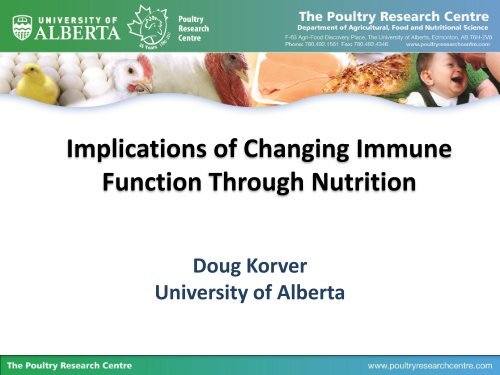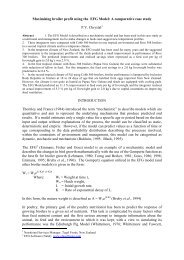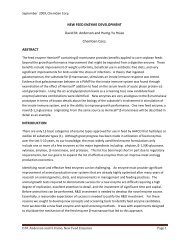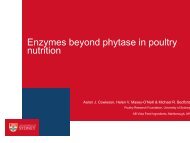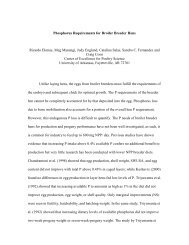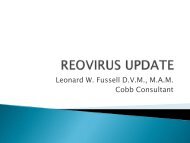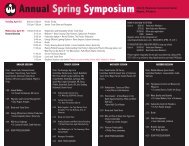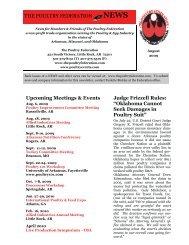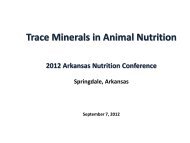Douglas Korver, Implications of Changing Immune Function ...
Douglas Korver, Implications of Changing Immune Function ...
Douglas Korver, Implications of Changing Immune Function ...
Create successful ePaper yourself
Turn your PDF publications into a flip-book with our unique Google optimized e-Paper software.
<strong>Implications</strong> <strong>of</strong> <strong>Changing</strong> <strong>Immune</strong><br />
<strong>Function</strong> Through Nutrition<br />
Doug <strong>Korver</strong><br />
University <strong>of</strong> Alberta
Nutritional Modulation <strong>of</strong> <strong>Immune</strong><br />
<strong>Function</strong><br />
• Development <strong>of</strong> immune system<br />
• Substrate supply<br />
• Nutritional immunity<br />
• Hormonal millieu<br />
• Regulatory actions <strong>of</strong> nutrients<br />
• Reduction <strong>of</strong> pathology<br />
• Physical/chemical actions in GI tract<br />
Klasing, 1998 Poultry Science 77:1119-1125
The <strong>Immune</strong> System<br />
• Two arms <strong>of</strong> the immune system<br />
– Adaptive Immunity<br />
• Targeted responses<br />
– Antibodies (humoral responses - B cells)<br />
– Directed cytotoxicity (cell-mediated - T cells)<br />
• Memory<br />
• Low energy expenditure
The <strong>Immune</strong> System<br />
• Two arms <strong>of</strong> the immune system<br />
– Innate immunity<br />
• Exclusion <strong>of</strong> pathogens<br />
• Local & systemic effects<br />
– Inflammation – phagocytosis, killing<br />
• No memory<br />
• Energetically costly
The <strong>Immune</strong> System<br />
• <strong>Immune</strong> system is a complex network<br />
– Communication between innate and adaptive<br />
• Eg antibody response requires innate cells<br />
– Vaccine adjuvants<br />
Adaptive Innate immunity<br />
Adaptive
Focus on Innate Immunity<br />
• Control disease through management<br />
– Vaccination, biosecurity, sanitation, etc.<br />
• Cost <strong>of</strong> activation<br />
– A vigorous antibody response requires little in the<br />
way <strong>of</strong> nutrients and energy<br />
– A vigorous inflammatory response can result in<br />
the loss <strong>of</strong> body weight
Immunology for Nutritionists<br />
• Innate immunity<br />
– A blunt instrument<br />
• Systemic effects<br />
– Fever<br />
– Decreased appetite<br />
– Metabolic inefficiencies<br />
– Skeletal muscle catabolism<br />
» Acute phase protein synthesis
Environment and Growth<br />
100<br />
90<br />
80<br />
70<br />
60<br />
50<br />
40<br />
30<br />
20<br />
10<br />
0<br />
K. Klasing<br />
IDEAL SANITATION<br />
0 5 10 15 20 25 30 35 40<br />
AGE
Environment and Growth<br />
100<br />
90<br />
80<br />
70<br />
60<br />
50<br />
40<br />
30<br />
20<br />
10<br />
0<br />
K. Klasing<br />
IDEAL SANITATION<br />
BARN ENVIRONMENT<br />
0 5 10 15 20 25 30 35 40<br />
AGE
% OF NON-INJECTED CONTROLS<br />
Inflammation & Performance<br />
110<br />
105<br />
100<br />
SALINE<br />
SRBC<br />
SEPHADEX<br />
LPS<br />
95<br />
90<br />
85<br />
80<br />
10<br />
0<br />
GAIN FEED GAIN/FEED<br />
K. Klasing
% OF NON-INJECTED CONTROL<br />
Inflammation & Body Composition<br />
130<br />
SALINE KILLED S. aureus LPS<br />
120<br />
110<br />
100<br />
90<br />
80<br />
70<br />
60<br />
10<br />
0<br />
K. Klasing<br />
INTESTINE LIVER SPLEEN PECTORALIS
Modern Poultry Production<br />
• Wild Jungle Fowl<br />
– Extensive<br />
– Exposure<br />
– Diet<br />
– SURVIVAL
Modern Poultry Production<br />
• Commercial production<br />
– Intensive<br />
– Biosecurity<br />
– Diet<br />
– Antibiotics<br />
– Vaccines<br />
– PERFORMANCE
Modern Poultry Production<br />
• ↑ risk <strong>of</strong><br />
infections<br />
• ↑ importance<br />
<strong>of</strong> immunity<br />
– Denmark –<br />
DANMAP 2005
The <strong>Immune</strong> System<br />
• What do we know about the immune system<br />
– Unintended consequences<br />
Adaptive<br />
Innate<br />
– What is advantageous under one set <strong>of</strong><br />
circumstances may be deleterious under others<br />
– Are we smart enough to figure this out
Nutritional Modulation <strong>of</strong> <strong>Immune</strong><br />
<strong>Function</strong><br />
• Development <strong>of</strong> immune system<br />
• Substrate supply<br />
• Nutritional immunity<br />
• Hormonal millieu<br />
• Regulatory actions <strong>of</strong> nutrients<br />
• Reduction <strong>of</strong> pathology<br />
• Physical/chemical actions in GI tract<br />
Klasing, 1998 Poultry Science 77:1119-1125
• Example -- Zinc<br />
– Zinc deficiency<br />
• ↓ innate immunity<br />
• ↓ adaptive immunity<br />
Minerals<br />
– zinc excess<br />
• ↓ innate immunity<br />
• ↓ adaptive immunity
<strong>Implications</strong><br />
• A “change” in immune function doesn’t mean<br />
“immunomodulation”<br />
– What levels must be fed in order to see a<br />
response<br />
– Does the change increase health and/or<br />
productivity
Selection for Growth<br />
• Growth rate has tripled in the last several<br />
decades (Havenstein et al. 2003)<br />
Broiler 50 years ago Broiler 30 years ago Today’s Broiler<br />
M. Zuidh<strong>of</strong>
Selection for Growth<br />
• Resource allocation theory (Rauw et al. 1998)<br />
– Selection against other traits<br />
• Eg. metabolic, reproductive<br />
Resource<br />
Reproduction<br />
Reproduction<br />
Growth<br />
Growth<br />
Immunity<br />
Immunity<br />
Metabolic<br />
Metabolic
Selection for Growth<br />
• Selection <strong>of</strong> broilers for performance:<br />
– reduced acquired immunity antibody production<br />
– reduced acquired immunity antibody production<br />
(Qureshi and Havenstein, 1994; Cheema et al., 2003)<br />
HOWEVER….<br />
– effects depend on the response being measured<br />
• modern broilers<br />
– reduced systemic response to pro-inflammatory challenges<br />
– reduced pro-inflammatory cytokines<br />
(Leshchinsky et al., 2001, Humphrey and Klasing, 2004; Xie et al., 2000)
Selection for Growth<br />
• Selection <strong>of</strong> broilers for growth<br />
– reduced acquired immunity antibody production<br />
– reduced acquired immunity antibody<br />
production<br />
(Qureshi and Havenstein, 1994; Cheema et al., 2003)<br />
HOWEVER….<br />
– effects depend on the response being measured<br />
• modern broilers<br />
– reduced systemic response to pro-inflammatory challenges<br />
– reduced pro-inflammatory cytokines<br />
(Leshchinsky et al., 2001, Humphrey and Klasing, 2004; Xie et al., 2000)
Commercial<br />
“C”<br />
Random bred 1957<br />
“R”
Temperature (°C)<br />
Fever response to<br />
42.2<br />
lipopolysaccharide (LPS)<br />
42<br />
41.8<br />
41.6<br />
41.4<br />
41.2<br />
41<br />
40.8<br />
40.6<br />
40.4<br />
40.2<br />
0 1 2 3 4 5 6 7 8 9 10 11 12 13 14 15 16 17 18<br />
CI<br />
RI<br />
CU<br />
RU<br />
Strain = P
Commercial<br />
“C”<br />
Random bred 1977<br />
“R77”<br />
Random bred 1957<br />
“R57”
Plasma IL-1 Activity after E. coli<br />
Infection<br />
Stimulation Index<br />
3.5<br />
3.0<br />
2.5<br />
2.0<br />
1.5<br />
1.0<br />
0.5<br />
0.0<br />
1957 1977 1998<br />
P>0.0785
T-cell Response to IL-1<br />
Stimulation Index<br />
50<br />
40<br />
30<br />
20<br />
10<br />
0<br />
a<br />
b<br />
b<br />
1957 1977 1998<br />
P>0.05
% E.coli killed<br />
Bactericidal Activity<br />
70<br />
60<br />
a<br />
a<br />
50<br />
b<br />
40<br />
30<br />
20<br />
10<br />
0<br />
R57 R77 2006 P
<strong>Implications</strong><br />
• Genetic selection for growth has altered<br />
immunity in broilers<br />
– Need good management<br />
– Diet manipulation<br />
– Immunomodulation<br />
• Selecting for innate immunity may be a way to<br />
address these issues<br />
– Selection for both BW and innate immunity can be<br />
achieved (Boa-Amponsem et al., 1998; Yunis et al., 2000)
Nutritional Modulation <strong>of</strong> <strong>Immune</strong><br />
<strong>Function</strong><br />
• Development <strong>of</strong> immune system<br />
• Substrate supply<br />
• Nutritional immunity<br />
• Hormonal millieu<br />
• Regulatory actions <strong>of</strong> nutrients<br />
• Reduction <strong>of</strong> pathology<br />
• Physical/chemical actions in GI tract<br />
Klasing, 1998 Poultry Science 77:1119-1125
The Chick<br />
• First week <strong>of</strong> life becomes more and more<br />
important<br />
– Greater proportion <strong>of</strong> life before slaughter<br />
M. Zuidh<strong>of</strong>
Innate Immunity<br />
• Begins to develop during early embryonic<br />
growth<br />
• <strong>Function</strong>ally immature
Innate <strong>Immune</strong> Development<br />
• Can we advance the developmental state at<br />
hatch<br />
– In ovo feeding<br />
– Maternal nutrition<br />
– Incubation conditions<br />
• Can we affect the rate <strong>of</strong> development during<br />
the first week
E. coli Killing by WBC<br />
E. Coli killed<br />
100<br />
80<br />
60<br />
40<br />
b<br />
a<br />
b<br />
a<br />
b<br />
a<br />
Control<br />
25-OH D 3<br />
b<br />
a<br />
%<br />
20<br />
0<br />
Early Mid Late<br />
Day 1<br />
Day 4 Day 1 Day 4 Day 1 Day 4<br />
Proportion <strong>of</strong> bacteria killed by WBC
<strong>Implications</strong><br />
• Early nutrition can influence early immune<br />
function<br />
• Greater reliance on bird’s immune system with<br />
removal <strong>of</strong> antibiotic growth promoters<br />
• Unintended consequences
Nutritional Modulation <strong>of</strong> <strong>Immune</strong><br />
<strong>Function</strong><br />
• Development <strong>of</strong> immune system<br />
• Substrate supply<br />
• Nutritional immunity<br />
• Hormonal millieu<br />
• Regulatory actions <strong>of</strong> nutrients<br />
• Reduction <strong>of</strong> pathology<br />
• Physical/chemical actions in GI tract<br />
Klasing, 1998 Poultry Science 77:1119-1125
n-3 vs n-6 Fatty Acids<br />
Arachidonic Acid (20:4n-6)<br />
COOH<br />
Eicosapentaenoic Acid (20:5n-3)<br />
COOH
n-3 vs n-6 Fatty Acids<br />
Arachidonic acid Eicosapentaenoic acid<br />
(20:4n-6)<br />
(20:5n-3)<br />
Cyclooxygenase Lipoxygenase<br />
Prostaglandin E 2 Leukotriene B 4<br />
Cyclooxygenase Lipoxygenase<br />
Prostaglandin E 3 Leukotriene B 5<br />
Inflammation<br />
Inflammation
20-C PUFA<br />
Cyclooxygenase<br />
Lipoxygenase<br />
L<strong>of</strong>rin<br />
Prostaglandin E<br />
Leukotriene B<br />
Inflammation
g/chick/d<br />
Body Weight Gain<br />
40<br />
38<br />
a<br />
a<br />
a<br />
ab<br />
a<br />
a<br />
a<br />
36<br />
34<br />
b<br />
32<br />
30<br />
0<br />
Control L<strong>of</strong>rin Control L<strong>of</strong>rin<br />
Corn Oil<br />
Non-infected<br />
Fish Oil<br />
Eimeria-infected<br />
Oil P
Stimulation Index<br />
3<br />
Serum IL-1 Activity<br />
2<br />
a<br />
a<br />
ab<br />
b<br />
1<br />
P
Nutritional Modulation <strong>of</strong> <strong>Immune</strong><br />
<strong>Function</strong><br />
• Development <strong>of</strong> immune system<br />
• Substrate supply<br />
• Nutritional immunity<br />
• Hormonal millieu<br />
• Regulatory actions <strong>of</strong> nutrients<br />
• Reduction <strong>of</strong> pathology<br />
• Physical/chemical actions in GI tract<br />
Klasing, 1998 Poultry Science 77:1119-1125
Nutritional Modulation <strong>of</strong> <strong>Immune</strong><br />
<strong>Function</strong><br />
• Reduction <strong>of</strong> pathology<br />
– cellular components <strong>of</strong> the immune system<br />
• reactive oxygen species (ROS)<br />
• catabolic enzymes<br />
– can cause damage to normal cells and tissues <strong>of</strong><br />
the host
g/chick/d<br />
Body Weight Gain<br />
40<br />
38<br />
a<br />
a<br />
a<br />
ab<br />
a<br />
a<br />
a<br />
36<br />
34<br />
b<br />
32<br />
30<br />
0<br />
Control L<strong>of</strong>rin Control L<strong>of</strong>rin<br />
Corn Oil<br />
Non-infected<br />
Fish Oil<br />
Eimeria-infected<br />
Oil P
Lesion Score<br />
2.5<br />
2.0<br />
ab<br />
Histopathology<br />
a<br />
1.5<br />
b<br />
b<br />
1.0<br />
0.5<br />
c<br />
c<br />
c<br />
c<br />
0<br />
Control<br />
L<strong>of</strong>rin<br />
Control<br />
L<strong>of</strong>rin<br />
Corn Oil<br />
Non-infected<br />
Fish Oil<br />
Eimeria-infected<br />
Diet X L<strong>of</strong>rin X Eimeria P
Diet n-3 PUFA and Rodent Survival<br />
Challenge Survival Challenge Survival<br />
Bacterial<br />
Viral<br />
Pseudomonas aeruginosa ↔ ↓ Cytomegalovirus ↔<br />
Klebsiella pneumonia ↑ Murine leukemia virus ↔↑<br />
Staphylococcus aureus ↑ Influenza ↔<br />
Salmonella typhimurium<br />
↔ ↓ ↓<br />
Protozoa<br />
Bacteroides fragilis ↓ Plasmodium yoelii ↑<br />
Streptococcus Group B ↑ Plasmodium berghei ↑<br />
Listeria monocytogenes<br />
GI flora (undefined)<br />
↔↓↓↓<br />
↑ ↑<br />
Anderson & Fritsche, 2002
<strong>Implications</strong><br />
• n-3 PUFA can “unlink” local and systemic<br />
responses<br />
• The “benefit” <strong>of</strong> n-3 PUFA depends on the<br />
type <strong>of</strong> disease challenge
Summary<br />
• Selection for growth has changed the immune<br />
system<br />
• Many nutrients can change immune function<br />
– Focus on those affecting innate immunity<br />
• Early protection <strong>of</strong> chicks<br />
• Inflammation reduces growth and efficiency
Conclusions<br />
• Understand the possible consequences<br />
• Using nutrition to manipulate immunity<br />
– Can start with the breeders<br />
– Great potential benefits<br />
– Potential problems<br />
– Good management is essential!


